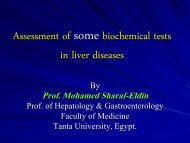Complications of Diabetes Mellitus
Complications of Diabetes Mellitus
Complications of Diabetes Mellitus
You also want an ePaper? Increase the reach of your titles
YUMPU automatically turns print PDFs into web optimized ePapers that Google loves.
Chronic <strong>Complications</strong> <strong>of</strong><br />
<strong>Diabetes</strong> <strong>Mellitus</strong><br />
Pr<strong>of</strong>essor Mamdouh El-Nahas<br />
Pr<strong>of</strong>essor <strong>of</strong> Internal Medicine<br />
Endocrinology and <strong>Diabetes</strong> Unit
Chronic complications <strong>of</strong> <strong>Diabetes</strong><br />
Macro<br />
Vascular<br />
Coronary<br />
Heart Dis.<br />
Micro<br />
and<br />
Macro<br />
Diabetic Foot<br />
Micro<br />
Vascular<br />
Neuropathy<br />
Stroke<br />
Retinopathy<br />
Peripheral<br />
Arterial Dis.<br />
Nephropathy
Macro vascular <strong>Complications</strong>
People with diabetes developing<br />
complications within<br />
9 years <strong>of</strong> diagnosis (%)<br />
In People with <strong>Diabetes</strong> Macrovascular<br />
<strong>Complications</strong> Are Two Times Greater than<br />
Microvascular <strong>Complications</strong><br />
25<br />
20<br />
20%<br />
15<br />
10<br />
9%<br />
5<br />
0<br />
Macrovascular complications Microvascular complications<br />
Adapted from Turner R et al Ann Intern Med 1996;124:136-145.
2/3 <strong>of</strong> People with <strong>Diabetes</strong> Die<br />
<strong>of</strong> Macrovascular Diseases<br />
67%<br />
Adapted from Alexander CM, Antonello S Pract Diabet 2002;21:21-28.
Macro vascular complications<br />
• PAD<br />
• CHD<br />
• Stroke
Macro vascular complications<br />
• PAD<br />
• CHD<br />
• Stroke
Does PAD differ in diabetic from<br />
nondiabetic Subjects ?<br />
• PAD is more common in <strong>Diabetes</strong>: 30% <strong>of</strong><br />
diabetic subjects older than 50 yrs have PAD.<br />
• Occurs at a younger age<br />
• Loss <strong>of</strong> female protection: A roughly equal<br />
male-to-female ratio
Different anatomical<br />
distribution:<br />
Predilection for the<br />
tibial and peroneal<br />
arteries between the<br />
knee and the foot.
• Diminished ability to establish collateral<br />
circulation, especially around the knee.<br />
• Increased risk <strong>of</strong> progression from<br />
intermittent claudication to critical limb<br />
ischemia and gangrene.
• Calcification<br />
involving the intimal<br />
plaque and media<br />
(medial calcinosis)<br />
frequently involves<br />
diabetic arteries at<br />
all levels.<br />
Medial calcinosis
Presentation <strong>of</strong> PAD<br />
• One-half are<br />
asymptomatic or<br />
have atypical<br />
symptoms,<br />
• One-third have<br />
claudication,<br />
• The remainder<br />
have more severe<br />
forms <strong>of</strong> the<br />
disease
Intermittent Claudication<br />
• Intermittent claudication, defined as pain,<br />
cramping, or aching in the calves, thighs, or<br />
buttocks that appears reproducibly with<br />
walking exercise and is relieved by rest.<br />
• The history <strong>of</strong> PAD is characteristic and<br />
consistently reproducible, and may alone be<br />
diagnostic for many individuals.
Signs <strong>of</strong> PAD<br />
Unlike other forms <strong>of</strong><br />
atherosclerotic disease, PAD is<br />
easily diagnosed in the outpatient<br />
clinic noninvasively.
• The dorsalis pedis pulse is reported to be<br />
absent in 8.1% <strong>of</strong> healthy individuals, and the<br />
posterior tibial pulse is absent in 2.0%.<br />
• Nevertheless, the absence <strong>of</strong> both pedal<br />
pulses, when assessed by a person<br />
experienced in this technique, strongly<br />
suggests the presence <strong>of</strong> vascular disease
• Temperature<br />
differences can<br />
be reliably<br />
assessed only<br />
when limbs have<br />
been exposed to<br />
a constant room<br />
temperature for<br />
10-20 minutes.
• Absence <strong>of</strong> hair growth, thin and shiny<br />
skin, dystrophic toenails, and cool, dry,<br />
fissured skin are signs <strong>of</strong> vascular<br />
insufficiency and should be noted.
Macro vascular complications<br />
• PAD<br />
• CHD<br />
• Stroke
Incidence <strong>of</strong> fatal<br />
or nonfatal MI (%)<br />
People with <strong>Diabetes</strong> Have MI Risk Levels<br />
Comparable to People with Prior MI<br />
25<br />
20<br />
20%<br />
19%<br />
15<br />
10<br />
5<br />
0<br />
<strong>Diabetes</strong> (no prior MI)<br />
Prior MI (no diabetes)<br />
• Patients with diabetes without previous MI have as high <strong>of</strong> a risk<br />
<strong>of</strong> MI as nondiabetic patients with previous MI.<br />
• These data provide a rationale for treating cardiovascular risk<br />
factors in diabetic patients as aggressively as in nondiabetic<br />
patients with prior MI.
Poor prognosis following<br />
a CV event<br />
People with diabetes are up to two times<br />
more likely to die than those without<br />
diabetes after an MI.
Mortality from myocardial<br />
infarction is increased in<br />
diabetes largely due to<br />
increased risk <strong>of</strong> heart<br />
failure in diabetes.
Macro vascular complications<br />
• PAD<br />
• CHD<br />
• Stroke
Increased prevalence <strong>of</strong> stoke in type 2 diabetes in comparison to the control.
Chronic complications <strong>of</strong> <strong>Diabetes</strong><br />
Macro<br />
Vascular<br />
Coronary<br />
Heart Dis.<br />
Micro<br />
and<br />
Macro<br />
Diabetic Foot<br />
Micro<br />
Vascular<br />
Neuropathy<br />
Stroke<br />
Retinopathy<br />
Peripheral<br />
Arterial Dis.<br />
Nephropathy
Micro Vascular complications
Micro vascular complications<br />
• Neuropathy<br />
• Retinopathy<br />
• Nephropathy
Micro vascular complications<br />
• Neuropathy<br />
• Retinopathy<br />
• Nephropathy
Definition<br />
• The presence <strong>of</strong> symptoms and/or signs<br />
<strong>of</strong> peripheral nerve dysfunction in people<br />
with diabetes after exclusion <strong>of</strong> other<br />
causes.
Classification
Mononeuropathies<br />
• Affect peroneal, median or ulnar nerves,<br />
• tend to occur at sites <strong>of</strong> entrapment or external<br />
compression.<br />
• Peroneal nerve palsy is characterized by<br />
weakness or paralysis <strong>of</strong> foot and toe extension<br />
and foot eversion. Impaired sensation over the<br />
dorsum <strong>of</strong> the foot and the lower anterior aspect<br />
<strong>of</strong> the leg. The ankle reflex is preserved as is<br />
foot inversion.
Cranial nerve palsies<br />
• <strong>of</strong>ten affect III, VI, IV and rarely VII nerves.<br />
• III nerve palsy is characterized by<br />
• 1.<br />
• 2.<br />
Acute onset<br />
Painful: severe pain around the eye.<br />
• 3. Intact papillary reactions: pupilloconstrictor<br />
fibres located peripherally so they are affected in<br />
lesions that produce compression e.g.<br />
aneurysm.
• 3rd nerve palsy :<br />
Left ptosis and<br />
diplopia.<br />
• Intact pupillary<br />
reactions are<br />
characteristic<br />
features <strong>of</strong> 3rd<br />
nerve palsy in<br />
diabetes.
Radiculopathy<br />
• truncal neuropathy may yield sensory<br />
manifestations ( band like or constricting<br />
pain in thoracic root) or<br />
• Motor manifestations (asymmetrical bulge<br />
in abdominal wall).
• Bulging <strong>of</strong> the left<br />
lower abdomenal wall<br />
due to truncal<br />
radiculopathy
Proximal motor neuropathy<br />
(amyotrophy)<br />
• More frequent in male type 2 diabetic<br />
· Unilateral or asymmetrical bilateral<br />
• Pain, wasting and weakness in proximal<br />
muscles <strong>of</strong> the lower limbs.<br />
• Often associated with polynuropathy and weight<br />
loss.<br />
• DD: Internal malignancy, chronic inflammatory<br />
demyelinating polyneuropathy.
Entrapment Neuropathies<br />
• 1-carpal tunnel syndrome: found in 5.8 % <strong>of</strong><br />
diabetic patients. It has a less favorable<br />
outcome after surgical decompression, as<br />
diabetes slows nerve regeneration.<br />
• 2- Ulnar neuropathy at the elbow affect 2.1%<br />
<strong>of</strong> diabetic patients<br />
• 3- Peroneal neuropathy at the fibular head<br />
affect 1.4–13% <strong>of</strong> diabetic patients.<br />
• 4- Lateral cutaneous nerve <strong>of</strong> the thigh<br />
(meralgia paresthetica) affect 0–1.0% <strong>of</strong><br />
diabetic patients.
Autonomic neuropathy
Peripheral neuropathy<br />
• Affect 25-35% <strong>of</strong><br />
diabetic patients<br />
• Gradual onset and<br />
progressive course.<br />
• Predominant sensory<br />
manifestations .
• Motor fiber may be<br />
affected producing<br />
wasting <strong>of</strong> small<br />
muscles <strong>of</strong> hand and<br />
feet.
Signs <strong>of</strong> sensory impairment
Pain and touch perception<br />
• Pain perception is assessed by pin prick<br />
testing. Pinprick should be delivered<br />
once per second and not over the same<br />
point. More rapid delivery <strong>of</strong> pinprick<br />
produce summation <strong>of</strong> the effect and may<br />
obscure sensory loss.<br />
• Light touch is assessed by cotton wool .
• Pressure<br />
perception is<br />
assessed by 10<br />
gm Semmes-<br />
Weinstein<br />
Mon<strong>of</strong>ilaments.<br />
Pressure perception
Vibration perception<br />
• Vibration sense is<br />
assessed by tuning<br />
fork or Biothesiometer
Thermal perception
• Percption <strong>of</strong> movement and position sense is tested<br />
in the fingers and toes .<br />
• In more severe cases, with loss <strong>of</strong><br />
proprioception, patients may demonstrate a<br />
positive Romberg's sign.<br />
• Examination <strong>of</strong> muscle status, tone, power: wasting<br />
<strong>of</strong> small muscles <strong>of</strong> the hand and feet is common in<br />
neuropathy <strong>of</strong>ten with minimal weakness.<br />
• Ankle reflex <strong>of</strong>ten lost (reduced or absent in elderly).
Pathogenesis<br />
3 main factors<br />
Vascular<br />
Metabolic<br />
Autoimmune<br />
auto AB<br />
in some patients<br />
Endoneurial<br />
microangiopathy<br />
Sorbitol accumulation<br />
Increased activity <strong>of</strong><br />
protein kinase C<br />
Oxygen free<br />
Radicals<br />
AGEs<br />
myoinistol depletion<br />
Reduced Na-K<br />
ATPase activity<br />
decreased Nitric<br />
oxide synthesis
Management <strong>of</strong> DPN<br />
1. Primary prevention<br />
2. Early detection and treatment<br />
3. Disease modifying treatments<br />
4. Symptomatic treatment <strong>of</strong> pain.<br />
5. Protect a foot that lost its natural protective<br />
mechanisms.
Management <strong>of</strong> DPN<br />
1. Primary prevention<br />
2. Early detection and treatment<br />
3. Disease modifying treatments<br />
4. Symptomatic treatment <strong>of</strong> pain.<br />
5. Protect a foot that lost its natural protective<br />
mechanisms.
• The DCCT and the UKPDS demonstrated that the<br />
risk <strong>of</strong> neuropathy and other complications can<br />
be dramatically reduced or delayed by<br />
intensified glycemic control in patients with type<br />
1 and 2 diabetes, respectively
Management <strong>of</strong> DPN<br />
1. Primary prevention<br />
2. Early detection and treatment<br />
3. Disease modifying treatments<br />
4. Symptomatic treatment <strong>of</strong> pain.<br />
5. Protect a foot that lost its natural protective<br />
mechanisms.
• The earlier the treatment <strong>of</strong> neuropathy the<br />
better will be the response to therapy.
Management <strong>of</strong> DPN<br />
1. Primary prevention<br />
2. Early detection and treatment<br />
3. Disease modifying treatments<br />
4. Symptomatic treatment <strong>of</strong> pain.<br />
5. Protect a foot that lost its natural protective<br />
mechanisms.
Tight blood glucose control<br />
• The stability rather than the actual level <strong>of</strong><br />
glycemic control may be more important in<br />
relieving neuropathic pain especially in its early<br />
stages.
Alpha Lipoic Acid<br />
A meta analysis proved that treatment with alphalipoic<br />
acid (600 mg/day i.v.) over 3 weeks is safe.<br />
It significantly improves both positive neuropathic<br />
symptoms and neuropathic deficits to a clinically<br />
meaningful degree in diabetic patients with<br />
symptomatic polyneuropathy.<br />
Ziegler et al Diabet Med. 2004 Feb;21(2):114-21<br />
ALADIN III Study
Benfotiamine<br />
• A lipid-soluble derivative <strong>of</strong> thiamine.<br />
• May reduce pain <strong>of</strong> PDN in a dose <strong>of</strong> 600 mg<br />
per day (Stracke et al 2008).<br />
• Prevent the Accumulation <strong>of</strong><br />
triosephosphates arising from high cytosolic<br />
glucose concentrations via the reductive<br />
pentosephosphate pathway.
PKC inhibitors {Ruboxistaurin (LY333531)}<br />
•Therapy for diabetic macular oedema<br />
and other diabetic angiopathies<br />
including D retinopathy, D peripheral<br />
neuropathy and D nephropathy.<br />
• A phase III trial <strong>of</strong> the protein kinase C β<br />
inhibitor ruboxistaurin has been<br />
disappointing after encouraging data from<br />
phase II studies were reported
Aldose reductase inhibitors (Epalrestat<br />
and Ranirestat)<br />
• Sorbitol pathway is involved in pathogenesis <strong>of</strong><br />
microvascular complications <strong>of</strong> diabetes.<br />
• Aldose reductase inhibitors are effective in<br />
experimental animals (Matsumoto et al 2009).<br />
• Safety!!!!
Inhibitors <strong>of</strong> glycation (aminoguanidine)<br />
• Studies <strong>of</strong> aminoguanidine have mainly focused<br />
on nephropathy.
Management <strong>of</strong> DPN<br />
1. Primary prevention<br />
2. Early detection and treatment<br />
3. Disease modifying treatments<br />
4. Symptomatic treatment <strong>of</strong> pain.<br />
5. Protect a foot that lost its natural protective<br />
mechanisms.
NSAID<br />
Short courses may be used<br />
Opioid analgesics<br />
Should be avoided. But<br />
tramadol can be used for up to<br />
6 months<br />
SSRI<br />
Debate about their<br />
effectiveness.<br />
Carbamazepine<br />
More effective in lancinating<br />
pain but it is a Toxic drug
Oxycarbazine More safe Derivative <strong>of</strong><br />
carbamazepine? Rapid titration <strong>of</strong><br />
the dose…. serious adverse events.<br />
Mexiletine<br />
May induce serious arrhythmia<br />
Capsaicin cream<br />
Helpful for superficial and localized<br />
pain and in allodynia<br />
Physiotherapeutic<br />
modalities<br />
Acupuncture, TENS, PENS, Static<br />
magnetic field therapy, lowintensive<br />
laser therapy,<br />
monochromatic infrared light
Tricyclic antidepressants<br />
1st line treatment, however, side effects are<br />
frequent. The tricyclic antidepressants have<br />
anticholinergic side effects.<br />
Gabapentin<br />
Effective and safe drug in a dose <strong>of</strong> 1800 mg<br />
/day (gradual increase <strong>of</strong> the dose every<br />
3days)<br />
Pregabalin<br />
SNRI (Dual selective<br />
serotonin noradrenaline<br />
reuptake inhibitor)<br />
Analog <strong>of</strong> gamma aminobutyric acid, has<br />
anticonvulsant, analgesic, and anxiolytic<br />
properties . The greatest effect was observed<br />
in patients treated with 600 mg/day<br />
(Freeman et al 2008)<br />
It relieves pain by increasing the synaptic<br />
availability <strong>of</strong> 5-HT and noradrenaline in the<br />
descending pathways that inhibit pain<br />
impulses.
Management <strong>of</strong> DPN<br />
1. Primary prevention<br />
2. Early detection and treatment<br />
3. Disease modifying treatments<br />
4. Symptomatic treatment <strong>of</strong> pain.<br />
5. Protect a foot that lost its natural protective<br />
mechanisms.
The neuropathic foot does not ulcerate<br />
spontaneously<br />
It is the combination <strong>of</strong> neuropathy with either:<br />
‣ Extrinsic factors (e.g., ill-fitting shoe gear or<br />
foreign body in shoe)<br />
‣ Intrinsic factors (e.g., high foot pressures or<br />
plantar callus) that results in ulceration.
Micro vascular complications<br />
• Neuropathy<br />
• Retinopathy<br />
• Nephropathy
• Diabetic retinopathy is the commonest<br />
cause <strong>of</strong> blindness worldwide.<br />
• Diabetic retinopathy increases with the<br />
duration <strong>of</strong> diabetes.<br />
• Progression <strong>of</strong> retinopathy <strong>of</strong>ten<br />
accelerated with poor control <strong>of</strong> diabetes<br />
and blood pressure.<br />
• Asymptomatic until become advanced, so<br />
fundus examination should be routinely<br />
done at least annually.
Background diabetic retinopathy<br />
• The first sign is the development <strong>of</strong><br />
microaneurysms (small red dots).<br />
• Superficial haemorrhages<br />
• Cotton wool spots are micro-infarcts within<br />
the retina.<br />
• Hard exudates (exudation <strong>of</strong> plasma rich<br />
in lipids and protein)
Proliferative retinopathy<br />
• Proliferative retinopathy is preceded by the<br />
widespread development <strong>of</strong> capillary nonperfusion.<br />
This ischaemia induces new<br />
blood vessels to grow.<br />
• New vessels do not give rise to any<br />
symptoms.<br />
• New vessels are prone to bleed,<br />
particularly if there is vitreous traction.
• Small haemorrhages give rise to the<br />
preretinal haemorrhage with further<br />
bleeding or traction, the blood seeps into<br />
the vitreous with the consequent loss <strong>of</strong><br />
vision.<br />
• Once new vessels have developed this is<br />
an indication for laser therapy.
Diabetic eye diseases<br />
1. Diabetic retinopathy<br />
2. Cataract which develops earlier in diabetes than<br />
in the general population.<br />
3. Error <strong>of</strong> refraction due to fluctuations in blood<br />
sugar leading to osmotic changes within the lens.<br />
4. Ocular Nerve palsies: The sixth and the third<br />
nerve are the most commonly affected. These<br />
nerve palsies usually recover spontaneously<br />
within a period <strong>of</strong> 3–6 months
Micro vascular complications<br />
• Neuropathy<br />
• Retinopathy<br />
• Nephropathy
Renal affection in <strong>Diabetes</strong><br />
Increased risk <strong>of</strong>:<br />
• Renal atherosclerosis<br />
• Urinary tract infections, papillary necrosis<br />
• Glomerular lesions, e.g. from basement<br />
membrane thickening and<br />
glomerulosclerosis.
Diabetic nephropathy<br />
• Approximately 40% <strong>of</strong> patients with type 1 and<br />
20% with type 2 diabetes develop nephropathy.<br />
• Some centres have reported a falling incidence<br />
rate <strong>of</strong> diabetic nephropathy in type 1 diabetes.<br />
This may reflect good-quality local care for<br />
diabetes
• Diabetic nephropathy is the most common<br />
cause <strong>of</strong> chronic kidney failure and endstage<br />
kidney disease in the United States.
Pathophysiology<br />
• The earliest functional abnormality in the<br />
diabetic kidney is renal hypertrophy<br />
associated with a raised glomerular<br />
filtration rate.<br />
• As the kidney becomes damaged by<br />
diabetes, the afferent arteriole becomes<br />
vasodilated to a greater extent than the<br />
efferent glomerular arteriole. This<br />
increases the intraglomerular filtration<br />
pressure.
• This increased intraglomerular pressure<br />
leads to increased shearing forces locally<br />
which are thought to contribute to<br />
mesangial cell hypertrophy and increased<br />
secretion <strong>of</strong> extracellular mesangial matrix<br />
material.<br />
• This process eventually leads to<br />
glomerular sclerosis.
• The initial structural lesion in the<br />
glomerulus is thickening <strong>of</strong> the basement<br />
membrane.<br />
• Associated changes result in disruption <strong>of</strong><br />
the protein cross-linkages which normally<br />
make the membrane an effective filter. In<br />
consequence, there is a progressive leak<br />
<strong>of</strong> large molecules (particularly protein)<br />
into the urine.
Stages <strong>of</strong> Diabetic nephropathy<br />
1. Elevated glomerular filtration rate with<br />
enlarged kidneys<br />
2. Intermittent Microalbuminuria<br />
3. Microalbuminuria<br />
4. Proteinuria and Nephrotic syndrome.<br />
5. ESRD
Early Detection <strong>of</strong> Diabetic Nephropathy<br />
• Clinical features are usually absent until<br />
advanced chronic kidney disease<br />
develops.<br />
• Therefore, we should evaluate urinary<br />
albumin excretion (microalbuminuria)<br />
annually in all subjects with diabetes.
Definitions<br />
• In healthy individuals, urinary albumin<br />
excretion is less than 30 mg per day.<br />
• Microalbuminuria is defined as urinary<br />
albumin excretion 30 -300mg/day or<br />
albumin:creatinine ratio (ACR) greater<br />
than 2.5 mg/mmol (men) or 3.5 mg/mmol<br />
(women).<br />
• Macroalbuminuria is defined as urinary<br />
albumin excretion >300mg/day
DD<br />
Other renal disease should be suspected:<br />
• In the absence <strong>of</strong> progressive retinopathy<br />
• If proteinuria develops suddenly<br />
• If significant haematuria is present
Management<br />
• Primary prevention<br />
• Optimal control <strong>of</strong> blood glucose and blood pressure.<br />
– The <strong>Diabetes</strong> Control and <strong>Complications</strong> Trial (DCCT) found that<br />
a reduction in mean HbA1c from 9.0% to 7.3% in people with<br />
type 1 diabetes was associated with a 39% reduction in<br />
microalbuminuria and 54% reduction in proteinuria over 6.5<br />
years.<br />
– The United Kingdom Prospective <strong>Diabetes</strong> Study (UKPDS) also<br />
showed that a reduction in blood pressure from 154/87 to 144/82<br />
mm Hg was associated with an absolute risk reduction <strong>of</strong><br />
developing microalbuminuria <strong>of</strong> 8% over 6 years in patients with<br />
type 2 diabetes
Microalbuminuria and proteinuria<br />
• Ensure good blood glucose control (HbA1c below 6.5-<br />
7.5%, according to the individual's target).<br />
• ACE inhibitors should be started and titrated to full dose<br />
in all adults with confirmed nephropathy (including those<br />
with microalbuminuria alone) and type 1 diabetes.<br />
• If ACE inhibitors are not tolerated, angiotensin ll receptor<br />
antagonists should be substituted but combination<br />
therapy with both ACE inhibitors and angiotensin ll<br />
receptor antagonists is not recommended at present.<br />
• ACE inhibitor and angiotensin ll receptor antagonists<br />
should be used with caution in those with:<br />
– Peripheral vascular disease or known renovascular disease<br />
– Raised serum creatinine
• Measure, assess and manage<br />
Cardiovascular risk factors aggressively<br />
(smoking, glucose, raised lipids, high<br />
blood pressure).<br />
• Blood pressure should be maintained<br />
below 130/80 mm Hg by addition <strong>of</strong> other<br />
antihypertensive drugs if necessary.
• Avoid high protein intake.<br />
• Avoid taking Contrast agents containing<br />
Iodine and NSAIDs.
Chronic complications <strong>of</strong> <strong>Diabetes</strong><br />
Macro<br />
Vascular<br />
Coronary<br />
Heart Dis.<br />
Micro<br />
and<br />
Macro<br />
Diabetic Foot<br />
Micro<br />
Vascular<br />
Neuropathy<br />
Stroke<br />
Retinopathy<br />
Peripheral<br />
Arterial Dis.<br />
Nephropathy
Diabetic Foot
The term diabetic foot indicate any foot<br />
pathology that results directly from diabetes<br />
or its long-term complications
The WHO definition <strong>of</strong> the diabetic foot<br />
• The foot <strong>of</strong> a diabetic patient that has the potential risk <strong>of</strong><br />
pathologic consequences including infection, ulceration<br />
and or destruction <strong>of</strong> deep tissues associated with<br />
neurologic abnormalities, various degrees <strong>of</strong> peripheral<br />
vascular disease and/or metabolic complications <strong>of</strong><br />
diabetes in the lower limb
• Diabetic gangrene doesn’t occur suddenly<br />
but is preceded by several stages
Gangrene<br />
Advanced Foot<br />
Pathology<br />
High Risk Foot<br />
Low risk Foot
Advanced foot Pathology<br />
• Diabetic Foot ulcers (Neuropathic,<br />
Neurischemic or Uschemic)<br />
• Diabetic foot Infections<br />
• Charcot foot
The high risk foot<br />
The high risk foot is the foot that has developed one or more<br />
<strong>of</strong> the following risk factors for ulceration:<br />
‣ Neuropathy<br />
‣ Ischaemia<br />
‣ Deformity<br />
‣ Trauma<br />
‣ Callus.<br />
‣ Nail pathology
The low risk foot<br />
The National Institute <strong>of</strong> Health and Clinical<br />
Excellence defines low-risk patients as those with<br />
normal sensation and palpable pulses
key educational elements for diabetic<br />
patients at low<br />
risk <strong>of</strong> complication<br />
Foot care education in patients with diabetes at low risk <strong>of</strong><br />
complications: a consensus statement. Diabet. Med. 28, 162–<br />
167 (2011)
CARE<br />
• Control: control blood glucose levels<br />
• Annual: attend your annual foot screening<br />
examination.<br />
• Report: report any changes in your feet<br />
immediately to your healthcare<br />
pr<strong>of</strong>essional.<br />
• Engage: engage in a simple daily foot care<br />
routine by washing and drying between<br />
your toes,moisturizing and checking for<br />
abnormalities.
• In order to prevent amputation, we should<br />
diagnose and treat any mild foot pathology<br />
before its progression into advanced foot<br />
pathology.
Low Risk Foot<br />
High Risk Foot<br />
Advanced Foot<br />
Pathology<br />
Gangrene
What can be done to prevent the development <strong>of</strong><br />
advanced foot pathology?<br />
• Regular inspection and examination <strong>of</strong> the foot.<br />
• Identification <strong>of</strong> the foot at risk.<br />
• Education <strong>of</strong> patient, family and healthcare<br />
providers.<br />
• Appropriate footwear.<br />
• Treatment <strong>of</strong> non ulcerative pathology









